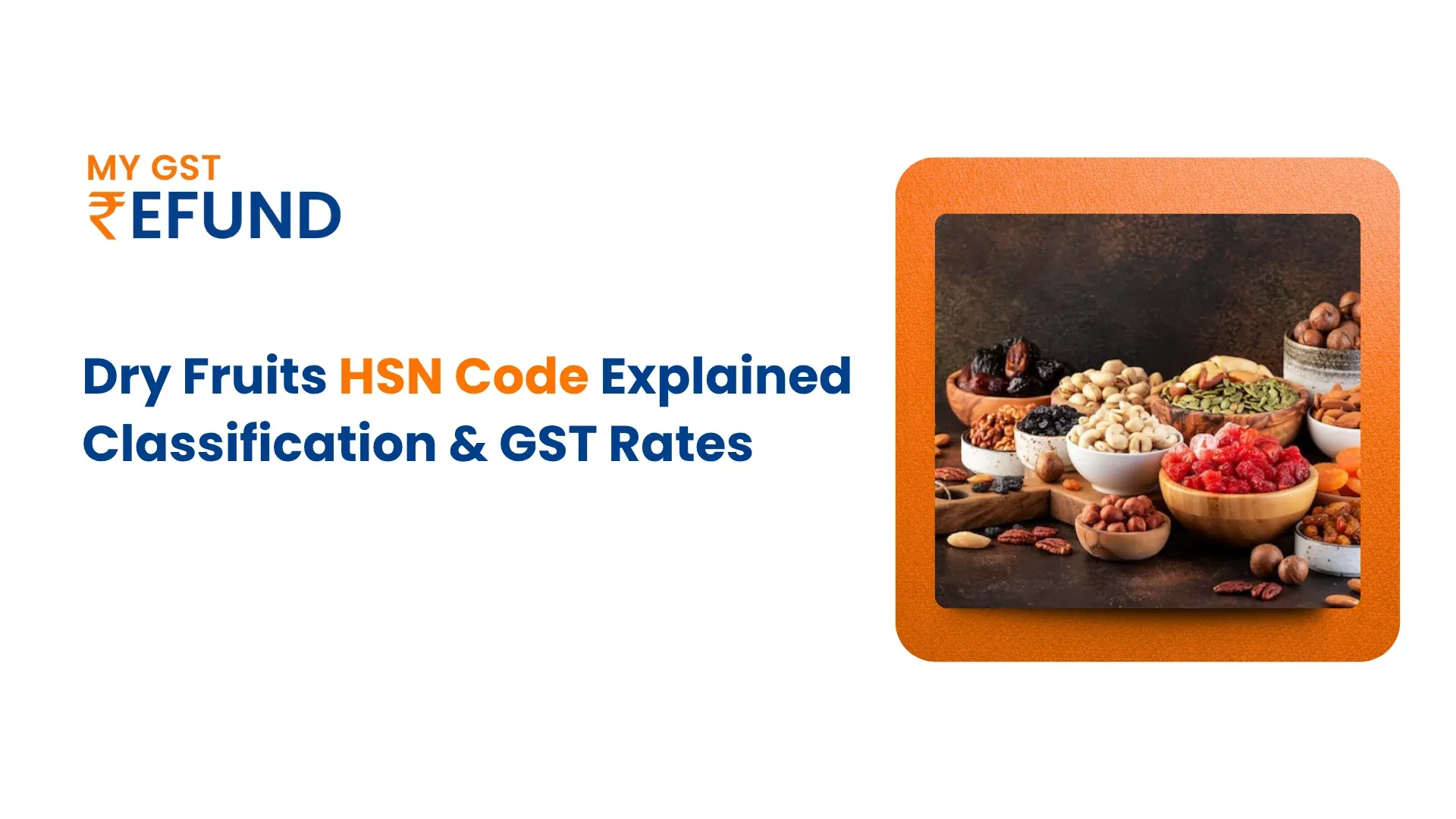Dry Fruits HSN Code Explained: Classification & GST Rates
The dry fruits industry is a significant sector of the Indian export market, serving both domestic and international markets with almonds, cashews, raisins, walnuts, and other healthy produce. For local traders or exporters, it is essential to know the HSN Code of dry fruits to file GST Returns correctly, Clear customs easily, and export without any inconveniences or complications.
As the taxation laws are being changed and the focus on transparency grows, knowing where the Dry Fruits fall under the HSN Code can aid in making the GST payments properly and reduce the risks of not keeping the balance and facing the consequences of non-compliance with the law in the course of the export operations. This guide explains all the requirements needed in regard to HSN classification, GST rates, and compliance implications on exporters in the dry fruit business.
Try our HSN Code Finder tool to find the current HSN code for your product or service.
What Is an HSN Code?
The HSN Code (Harmonized System of Nomenclature) is an international system of classification of goods to be taxed and traded. This system was introduced by the World Customs Organization (WCO) and uniquely codes each product with a numerical code that makes the process of customs easier and also makes it consistent across borders.
India adheres to the HSN system of classification of tax rates in the context of GST. The initial two numbers depict the product chapter, the third and fourth are the headings, and the fifth and sixth are the subheadings. As an exporter and trader, a proper HSN Code in dry fruits would mean that both domestic GST laws and international trade documentation are followed.
Importance of HSN Code in Dry Fruits Exports.
Dry Fruits HSN codes have various uses other than taxation in the case of exporters. They automate documentation and increase the precision in export declarations, and keep delays to a minimum when clearing through customs.
The misclassification of HSN can result in inconsistencies between the invoice of export, shipping bills, and GST filing, leading to delays in the refunds or even fines.
Furthermore, when submitting an Export GST Refund or IGST Refund, the right HSN code will make sure that the export product is consistent with the stated category of item within the GST system. Therefore, ensuring the accuracy of the HSN Code in dry fruits for export is not merely a matter of compliance; it is an important business strategy in terms of financial efficiency.
Dry Fruits Classification Under HSN Codes.
Dry fruits will be grouped under Chapter 08 of the HSN classification system that relates to Edible Fruits and Nuts; Peel of Citrus Fruit or Melons. In this chapter, there are various sets of codes depending on the kind of dry fruits and their processing.
Some typical categories of exporters and traders include those below:
- 0801: Coconuts, Brazil nuts, and cashew nuts (with or without shelling or peeling).
- 0802: Other nuts, including almonds, hazelnuts, and walnuts (shelled or unshelled).
- 0804: Dates, figs, pineapples, avocados, mangoes, and mangosteens, dried.
- 0806: Grapes, including raisins.
- 0813: Dried fruits not otherwise specified, e.g., mixtures of fruits and nuts, etc.
These Dry Fruits Under HSN Codes are very important to the exporters as even a minor mistake in classification can affect the taxation, Calculations of duty, and eligibility to receive GST Refund.
In India, as an example, almonds and walnuts might seem like the same on the trade, but they belong to different groups of HSN subcategories, which would be charged different GST rates. Proper classification will enable exporters to have no legal problems when auditing or refunding.
GST Rates Applicable to Dry Fruits
GST on dry fruits differs according to the type of the fruit, and whether it is shelled, roasted, salted, or sweetened.
The following is an oversimplified picture of the relevant rates:
- 0% GST: Fresh fruits (non-processed and non-dried) are not subject to GST.
- 5% GST: Unsalted and unroasted dry fruits (frequently used), which include cashews, almonds, raisins, walnuts, and dates.
- 12-per-cent GST: Roasted or salted dry fruits and flavouring mixtures.
- 18% GST: Dry fruit products such as sweetened mixes, nut blends, or processed snacks.
The knowledge of the GST rate on dry fruits will guarantee the correct calculation of tax on domestic and export transactions. Exports are treated as zero-rated supplies under GST. Exporters can either export without paying IGST under an LUT and claim a refund of unutilized ITC under Section 54(3) of the CGST Act, 2017, or export by paying IGST and claim a refund of the tax paid under Section 54(1).
This has enabled exporters to keep a healthy cash flow growth in the export and prevent needless clogging of operating capital.
Effects of HSN Code on Exporters.
The accurate HSN code has an impact on nearly all export processes, including invoicing and shipping documentation, GST compliance, as well as refunds. To exporters, correctly using HSN codes makes the process of filling Export documentation easier, and it makes the exporters eligible to claim the refunds through Export GST. The mistakes or discrepancies in HSN codes might result in delayed refunding, enhanced examination by the customs, or total refusal of refund requests.
Moreover, a proper classification contributes to efficient financial management because proper tax treatment is guaranteed within various product lines. Failure to regularly report HSN may cause discrepancies between GST-1 and GST-3B filing and which impacts the refund cycle and audit quality of the exporter.
Through uniformity in invoices, Shipping bills, and GST filings, the exporters will help optimize the cash flow in the export business and will guarantee the continuous working capital.
Technology in HSN and GST Management.
Technology is a crucial component in making GST compliant and simplifying the classification of HSN used by exporters. The use of highly automated software is capable of automatic recognition of the correct codes, cross-indenting invoice records, and real-time adherence to the GST regulations.
An HSN Code Finder is an application that assists companies in finding the correct classification of companies, such as dry fruits, in a short time, before allowing them to make mistakes when filing and reporting. It is also easy to create GST-compliant invoices and reconcile the invoices with return filings using these digital tools, and this saves a lot of manual work, hence reducing human error.
Conclusion
Knowledge of the correct Dry Fruits HSN Code, along with its application, is essential in the correct filing of GST, exportation of goods, and for refund eligibility. Having a variety of kinds and types of product processing of dry fruits, the business should classify them accurately to be able to provide the business with a smooth running and profitable functioning.
In case you are a dry fruit exporter, you may be eligible for an Export GST. Connect with MYGST Refund today. “We are India’s #1 automated GST refund platform, for expert guidance and end-to-end support”. Export compliance is made easy through our platform, and faster refunds are ensured.
Frequently Asked Questions (FAQs)
1. What is the HSN Code for dry fruits under GST?
Dry fruits generally fall under HSN Chapter 08. Some common Codes include: 0801 (Cashews), 0802 (Almonds / Walnuts), and 0813 (Mixed Dried Fruits).
2. What is the GST rate applicable to dry fruits?
Most dry fruits, which are unsalted and unroasted, will attract 5% GST. However, roasted or processed dry fruits will be under higher rates (12% or 18%).
3. What is the significance of the correct HSN Code for Dry fruit exporters?
Utilizing the correct HSN code ensures accurate GST compliance, export documentation, as well as refund compliance, thus significantly reducing the risk of compliance attention to exporters and preventing delays in refunds.
4. How can exporters claim a GST refund on dry fruit exports?
Exporters can either export under LUT (thereby avoiding the payment of the IGST) or pay the IGST on export and later initiate a claim for refund of the GST using the GST portal under the IGST refund process.
5. How do the HSN Codes affect Export GST Refunds?
Using incorrect HSN codes on invoices can create discrepancies between the filings of the GST Returns in the invoice and the GST Return filed with the assigned HSN Codes, further impacting the approval and payout timelines of the refund. Accurate HSN Codes will make for a faster approval and payout strategy.
Related Posts







